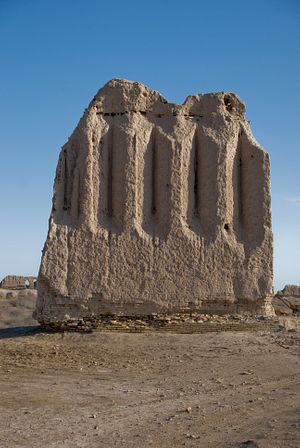After the rise and consolidation of Islamic civilization, one of the Islamic World’s most important and largest cities along with Baghdad and Cairo was the eastern Persian city of Merv (Persian: مرو, also known as Marv or Mary), today located in southern Turkmenistan. Yet while Cairo and Baghdad are still going strong (though Baghdad spent most of the time after its destruction by the Mongols in 1258 as a mere provincial town), what of Merv?
In fact, the historic city of Merv was totally wrecked 230 years ago in 1785—though it was already in a state of decline before then. The modern town of Mary was later founded near the ruins of Merv in 1884 by the Russians, who by then ruled the region. It is but a shadow of the former glory of Merv.
Merv is located in an oasis near the Murghab river delta (which peters out in the Karakum Desert); a system of canals and dams historically enhanced the region’s water supply. For much of the Middle Ages, Merv was in fact the largest and primary city of the region of Khorasan, the mostly Persian-speaking region in parts of today’s Central and South Asia. By around 1150 CE, it may have been the world’s largest city at the time, when it was the eastern capital of the Great Seljuk Sultanate, the Turkic state that dominated the area from Central Asia to Anatolia, including Iran. The Abbasid Caliph in Baghdad had become a figurehead at this point and power in the Islamic world was in the hands of various sultans, kings, emirs, and the like.
The city was reportedly founded by Alexander the Great and strengthened by the Sassanian Persian Empire. After the Arabs conquered the Sassanians, Merv became the base of the Caliphate in Central Asia, and was the area where the distinctively Persian characteristics of eastern Islam began to take root. The Abbasid revolt that brought down the Umayyad Caliphate and led to the Abbasid Caliphate began under one Abu Muslim in 747 in Merv (the Abbasids would eventually make Baghdad their capital after their victory in 750).
Merv remained the capital of Khorasan for a while, but other nearby cities began to grow in importance as local Persianate dynasties began to emerge and become autonomous from the Abbasids; these cities included Herat, later called the “Pearl of Khorasan” after the Mongols sacked Merv, and Nishapur in northeastern Iran. Many of these dynasties were eventually swept aside by the Seljuk Turks who made Merv a magnificent city. It was considered a center of science and literature. Later, it was under the rule of the Khwazamian Empire, which angered Genghis Khan. The subsequent Mongol invasion destroyed many of Central Asia’s greatest cities. Contemporary chronicles claimed that over 1.3 million people were slaughtered by the Mongols in Merv from 1220-1223: an exaggeration probably, but one that still indicates the scale of destruction there. Herat and Mashhad, further to the south, and more sheltered by the Iranian plateau, became more prominent cities in Khorasan. The region’s irrigation also suffered serious damage, which made it hard to reestablish settled, agricultural life in a desert region.
But although the city declined, it managed to pull through for a while. A Timurid ruler rebuilt some of the irrigation in 1409, and the city became an important regional center under the Persian Safavid Empire, after the Battle of Merv (1510), at which time it became a Shia town. However, during this period, it suffered constant harassment and attacks by the (Sunni) Uzbeks, who justified attacking the Persians and enslaving them as they were Shia and thus, in Uzbek eyes, infidels. The size of this Merv was not at all comparable to the pre-Mongol Merv, and the major centers of Persian and Islamic civilization mostly moved away from Central Asia by this time, due to reasons of power and trade. Safavid Iran developed a more coastal oriented trading pattern during this time, exporting rugs and silk from the new city of Bandar Abbas on the Persian Gulf, instead of relying on overland trade from Central Asia.
After the Safavids, Merv, by then a small, declining town, was ruled by the Persian Qajars until 1785 when it suffered its final calamity. The Uzbek ruler of Bukhara in today’s Uzbekistan, Shah Murad captured Merv, killing its ruler. He destroyed the dam and diverted the river, turning Merv into a wasteland (until the Russians arrived). Murad carried away the city’s population of 100,000 to the Uzbek heartland in Bukhara. To this day, there are some Shia Persian “Iranians” in Uzbekistan.

































